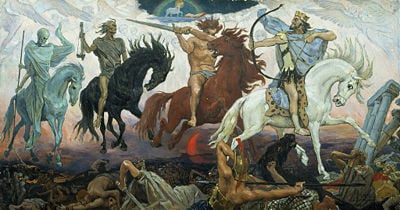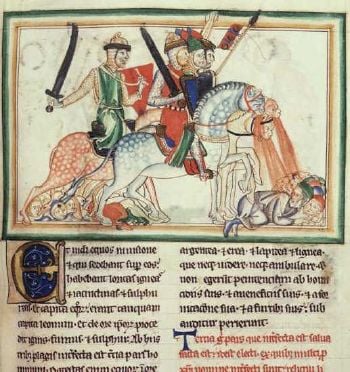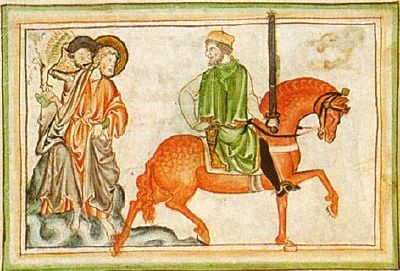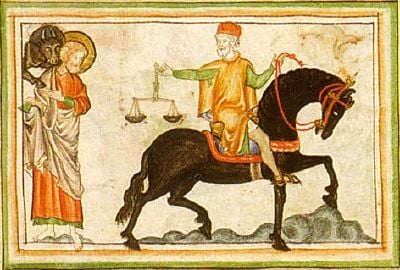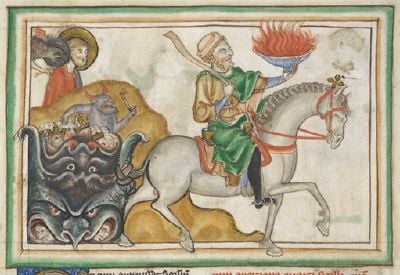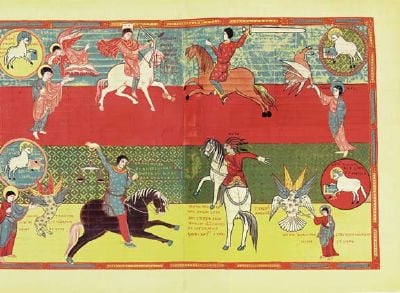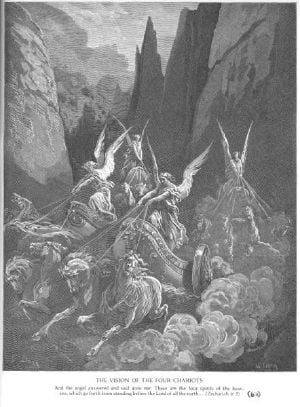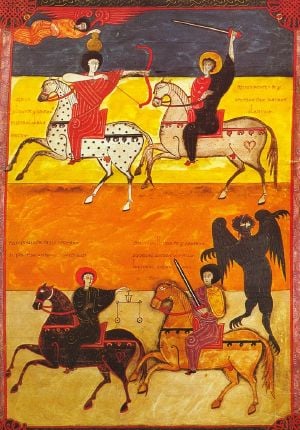Difference between revisions of "Four Horsemen of the Apocalypse" - New World Encyclopedia
| (34 intermediate revisions by 10 users not shown) | |||
| Line 1: | Line 1: | ||
| − | {{ | + | {{Images OK}}{{submitted}}{{approved}}{{Paid}}{{copyedited}} |
| − | + | [[Image:Apocalypse vasnetsov.jpg|thumb|400px|Four Horsemen of the Apocalypse, traditionally understood as either Christ or Antichrist, War, Famine and Death]] | |
| − | The Four Horsemen of the Apocalypse | + | The '''Four Horsemen of the Apocalypse''' are a group of mythical riders described in Chapter 6, verses 1-8 in the [[Book of Revelation]], also known as the Apocalypse of John, the last book of the [[New Testament]]. The Horsemen each ride on a colored [[horse]]—white, red, black, and pale (green)—and represent various dramatic qualities. Regarding three of the Horsemen, there is a basic consensus as to their meaning, with red symbolizing [[war]], black symbolizing [[famine]], and pale representing [[death]] and [[disease]]. The rider of the white horse is more controversial. Some consider him to represent [[Christ]], while others believe he symbolizes the [[Antichrist]]. |
| + | {{toc}} | ||
| + | The vision of the Four Horsemen describes events related to the [[Last Days]], interpreted by some as relating to the future and by others as describing events occurring in the times when the author of the Book of Revelation was writing, during the pre-Christian Roman Empire. Still others believe that the events should be interpreted allegorically, as spiritual truths rather than specific events from the past or future. | ||
| − | The | + | ==Context== |
| + | The Four Horsemen appear in the [[Book of Revelation]], in which a heavenly being called the Lamb opens seven seals revealing the events related to the [[Second Coming of Christ]], also referred to as the [[Last Days]]. It was written during a period of serious persecution against the Christian church by the [[Roman Empire]]. The Four Horsemen are described as each of the first four seals are opened. | ||
| − | The Four Horsemen | + | ==The horses and their riders== |
| + | ===White horse=== | ||
| + | [[Image:BritLibAddMS35166ApocalypseFolio016rFourHorsemen.jpg|thumb|350px|right|The Four Horsemen, with the white horse in the foreground]] | ||
| + | The first horse is described as follows: "I watched as the Lamb opened the first of the seven seals. Then I heard one of the four living creatures say in a voice like thunder, 'Come!' I looked, and there before me was a white horse! Its rider held a bow, and he was given a crown, and he rode out as a conqueror bent on conquest" (Rev. 6:1-8 NIV). | ||
| − | + | There are diverse opinions on whether the first horseman, riding a white horse, represents Christ or is the so-called anti-Christ. Until the time of the [[Protestant Reformation]], the traditional view was that the rider of the white horse was Christ. This view is largely based on the presumption that a later reference to a rider on a white horse is the same as the rider referred to above. Revelation 19:11-16 states: "I saw heaven standing open and there before me was a white horse, whose rider is called Faithful and True. With justice he judges and makes war… On his robe and on his thigh he has this name written: KING OF KINGS AND Lord OF LORDS." | |
| − | + | With the Reformation, however, some interpreters have viewed the rider on the first white horse as the [[antichrist]], while the rider of the second white horse is viewed as Christ at the Second Advent.<ref>Glenn Kreider, ''Jonathan Edwards' Interpretation of Revelation 4:1-8:1'' (Univ. Press of America, 2004, ISBN 978-0761826705).</ref> | |
| − | |||
| − | + | ===Red horse=== | |
| + | [[Image:BritLibAddMS35166ApocalypseUnkFolio2SealRedHorse.jpg|thumb|400px|The Red Horse]] | ||
| + | The second horseman is described as riding a red horse: "When the Lamb opened the second seal, I heard the second living creature say, 'Come!' Then another horse came out, a fiery red one. Its rider was given power to take peace from the earth and to make men slay each other. To him was given a large sword" (Rev 6:3-4 NIV). | ||
| − | + | The rider of the second horse is generally held to represent War. The red color of his horse represents blood spilled on the battlefield. He carries a great sword, which represents battle and fighting. The Red horse is also said to represent the planet [[Mars]], the planet of the god of war. | |
| − | + | ===Black horse=== | |
| + | [[Image:BritLibAddMS35166ApocalypseUnkFolio3SealBlackHorse.jpg|thumb|right|400px|The Black Horse]] | ||
| + | The third horseman is described as riding a black horse: "When the Lamb opened the third seal, I heard the third living creature say, 'Come!' I looked, and there before me was a black horse! Its rider was holding a pair of scales in his hand. Then I heard what sounded like a voice among the four living creatures, saying, 'A quart of wheat for a day's wages, and three quarts of barley for a day's wages, and do not damage the oil and the wine!'" (Rev. 6:5-6 NIV). | ||
| − | + | This third horseman is generally considered to symbolize a great famine, likely as a result of the war that comes from the second horseman. Staple food items such as wheat and barley will be extremely scarce. | |
| − | |||
| − | The | + | ===Pale horse=== |
| + | [[File:Apocalypse - BL Add MS 35166 f008v - Forth horseman.jpg|thumb|400px|The Pale Horse]] | ||
| + | The fourth horseman is described as riding a pale horse. His named is specifically referred to as "Death." The text reads: "I heard the voice of the fourth living creature say, 'Come!' I looked, and there before me was a pale horse! Its rider was named Death, and Hades was following close behind him. They were given power over a fourth of the earth to kill by sword, famine, and plague, and by the wild beasts of the earth (Rev. 6:7-8). | ||
| − | + | The pale color of the fourth horse is thought to represent fear, sickness, decay, and death. The word used to describe the color of the pale horse is the Greek word ''chloros,'' or green. It is meant to convey the sickly green tinge of the deathly ill or recently dead. Since the literal translation does not carry these connotations in English. the word is rendered "pale" in most English translations. | |
| − | |||
| − | |||
| − | + | ===The other seals=== | |
| − | + | After each of the first four seals is opened to reveal the Four Horsemen, a fifth seal is opened. It reveals a great slaughter of [[martyr]]s persecuted because of their faith in God's word. The sixth seal reveals a great [[earthquake]] and heavenly portents such as the sun turning black and moon turning red, as mighty rulers flee from the impending wrath of the Lamb. The author also reports a vision of 144,000 saints who will be sealed by the Lamb to protect them from the coming tribulations (Rev. 7). The seventh seal reveals seven angels, each with a trumpet, which when blown reveals additional calamities. All of this is but a precursor to more disasters, temptations, and finally the [[Second Coming of Christ]]. | |
| − | |||
| − | |||
| − | === | ||
| − | |||
| − | |||
| − | |||
| − | |||
| − | |||
| − | The | ||
| − | |||
| − | |||
| − | |||
| − | |||
| − | |||
| − | |||
| − | The | ||
| − | |||
| − | |||
| − | |||
| − | |||
| − | |||
| − | |||
| − | |||
| − | |||
| − | |||
| − | |||
| − | |||
| − | |||
| − | |||
| − | |||
| − | |||
| − | |||
| − | |||
| − | |||
| − | |||
| − | |||
| − | |||
| − | |||
| − | |||
| − | |||
| − | |||
| − | |||
| − | |||
| − | |||
| − | |||
| − | |||
| − | |||
| − | |||
| − | |||
| − | |||
| − | |||
| − | |||
| − | |||
| − | |||
| − | |||
| − | |||
| − | |||
| − | |||
| − | |||
| − | |||
| − | |||
==Interpretations== | ==Interpretations== | ||
| + | [[Image:ApocalypseStSeverFol108v109r4Horsemen.jpg|thumb|400px|The Apocalypse as depicted in Saint-Sever, France]] | ||
| − | There are | + | There are four basic schools of thought on how the [[Book of Revelation]] is to be interpreted. Each of them also has various permutations and applications regarding the issue of the Four Horsemen. |
| − | |||
| − | |||
| − | |||
| − | |||
| − | |||
| − | |||
| − | |||
| − | |||
| − | |||
| − | |||
| − | |||
| − | ===''' | + | ===Preterism=== |
| − | The ''' | + | The term ''preterism'' comes from Latin for "past." It refers to the belief that the events in the [[Book of Revelation]] actually occurred in the past. ''Full preterism'' describes the belief that these events were fulfilled with the fall of [[Jerusalem]] and the destruction of the [[Temple of Jerusalem]] in 70 C.E. by the [[Roman Empire]] (which is identified in Revelation as "the beast"), thus initiating the start of the Christian age. The [[Last Days]] are thus identified as the time period between the ministry of [[John the Baptist]] and the fall of [[Jerusalem]], and the tribulation is identified as the destruction of Jerusalem and the forced [[exile]] of its people.<ref>[https://www.ligonier.org/podcasts/simply-put/preterism Preterism] ''Ligonier''. Retrieved October 8, 2022.</ref> ''Partial preterism'' divides the end-times prophecy into several parts. In this view, certain parts of Revelation have yet to be fulfilled, such as the resurrection of the dead and the coming of the heavenly New Jerusalem, while other parts have already happened. |
| − | + | ===Futurism=== | |
| + | This view believes that the [[Book of Revelation]] is a prophecy of future events to come, which will occur shortly before the [[Second Coming]] of Christ. In this view, none of the Four Horsemen has appeared yet. | ||
| − | + | ===Historicism=== | |
| + | The historicist view regards the prophecy in Revelation as being in the process of being fulfilled. That process started at the end of the first century and will continue through the Second Coming of Christ. | ||
| − | === | + | ===Allegory=== |
| − | The '' | + | The allegorical, or ''spiritual'' view, does not see the contents of the Book of Revelation as literal. Rather its language is symbolic, and each generation can read and interpret it in their own way. The various visions in the Book of Revelation express eternal spiritual truths and struggles that are without any literal or historical application. Revelation is seen as having several levels of meaning, which range from a strict and literal interpretation to an interpretation that cannot be understood and interpreted only on the basis of one's intellect. |
| − | == | + | ==Relationship to the Book of Zechariah== |
| − | Four | + | [[Image:Four-chariots.jpg|thumb|300px|The prophet Zechariah's vision of four chariots, anticipating the Four Horsemen of the Apocalypse]] |
| + | The Four Horsemen of the Apocalypse bear a marked similarity to the four sets of horses that are similarly depicted in the [[Book of Zechariah]] (6:1-8), the second to last book in the [[Old Testament]]. | ||
| − | The text in the book of Zechariah (Zech 6:1- | + | The text in the book of Zechariah (Zech 6:1-5) reads as follows: (Revised Standard Version) |
| − | + | <blockquote>And again I lifted my eyes and saw, and behold, four chariots came out from between two mountains; and the mountains were mountains of bronze. The first chariot had red horses, the second black horses. The third white horses, and the forth chariot dappled gray horses. Then I said to the angel who talked to me, "What are these, my lord? And the angel answered me, "These are going forth to the four winds of heaven, after presenting themselves before the Lord of all the earth."</blockquote> | |
| − | |||
| − | |||
| − | |||
| − | |||
| − | |||
| − | |||
| − | |||
| − | + | In Zechariah, all of the horses and riders are servants of [[Yahweh]]. If these horses are the same four horses and riders as the Four Horsemen, this would suggest that the rider of the white horse in the Book of Revelation is not the Antichrist, who is depicted in Revelation as a servant of Satan. | |
==Significance== | ==Significance== | ||
| + | [[Image:B Facundus 135.jpg|thumb|right|300px|The Four Horsemen, at the National Library in Madrid]] | ||
| + | The [[Book of Revelation]] contains an account of several powerful visions. Whether or not these visions were real experiences of the author or simply literary conventions is an open question. The Four Horsemen in particular have presented the Christian world with a fearful sense of apocalyptic foreboding, in which the world will be struck by the horrors of war, famine, plague, and death before the Second Coming of Christ. Periods of wars, famines, and plagues have thus often been interpreted as evidence of the [[Last Days]], stimulating both messianic hope and widespread fear, together with the rise of various millenarianism sects. | ||
| − | The Book of | + | This much, however, is certain: The Four Horsemen of the Apocalypse cannot be adequately understood except against the historical background in which the Book of Revelation was written. Like the Book of Zechariah and other [[Old Testament]] apocalypses, it is composed as resistance literature to meet a crisis, which was the ruthless persecution of the early Christian church by the Roman government. This book is thus seen as an exhortation and admonition to Christians of the first century to stand firm in their faith and to avoid compromise with paganism, despite the threat of death. The early Christians were encouraged to wait for the fulfillment of the promises made by Jesus, which would be the triumph of God's sovereignty. |
| − | This | + | This book remains just as valid for present day Christians, who believe that the prophecies in Revelation apply to events of today. They are thus encouraged, as the first century Christians were encouraged, to remain faithful to the end, in the face of the serious problems confronting today's world, and to have faith and trust in the promise of Jesus, "Behold, I am with you always, until the end of the age" (Matthew 28:20). |
| − | + | ==Notes== | |
| + | <references/> | ||
==References== | ==References== | ||
| − | *Friesen, Steven J. | + | * Cunningham, Andrew, and Ole Peter Grell. ''The Four Horsemen of the Apocalypse: Religion, War, Famine, and Death in Reformation Europe''. Cambridge University Press, 2000. ISBN 978-0521467018 |
| − | *Henry, Matthew | + | * Friesen, Steven J. ''Imperial Cults and the Apocalypse of John.'' Oxford University Press, 2001. ISBN 978-0195131536 |
| + | * Graham, Billy. ''Approaching Hoofbeats: The Four Horsemen of the Apocalypse''. Avon Books, 1985. ISBN 978-0380699216 | ||
| + | * Henry, Matthew. ''Matthew Henry's Commentary: On the Whole Bible''. Hendrickson Pub., 2006. ISBN 1598560786 | ||
| + | * Kreider, Glenn. ''Jonathan Edwards' Interpretation of Revelation 4:1-8:1''. Univ. Press of America, 2004. ISBN 978-0761826705 | ||
| − | ==External | + | ==External links== |
| − | + | All links retrieved October 9, 2022. | |
| − | * | + | * [https://www.newadvent.org/cathen/01594b.htm Apocalypse]. ''New Advent''. |
| − | + | * [https://www.christianity.com/wiki/end-times/who-are-the-four-horsemen-in-revelation-their-meaning-and-significance.html Who Are the Four Horsemen in Revelation? Their Meaning and Significance] ''Christianity.com''. | |
| − | |||
| − | * | ||
| − | |||
| − | |||
| − | |||
| − | |||
[[Category:philosophy and religion]] | [[Category:philosophy and religion]] | ||
{{Credit|151221886}} | {{Credit|151221886}} | ||
Revision as of 18:16, 18 February 2023
The Four Horsemen of the Apocalypse are a group of mythical riders described in Chapter 6, verses 1-8 in the Book of Revelation, also known as the Apocalypse of John, the last book of the New Testament. The Horsemen each ride on a colored horse—white, red, black, and pale (green)—and represent various dramatic qualities. Regarding three of the Horsemen, there is a basic consensus as to their meaning, with red symbolizing war, black symbolizing famine, and pale representing death and disease. The rider of the white horse is more controversial. Some consider him to represent Christ, while others believe he symbolizes the Antichrist.
The vision of the Four Horsemen describes events related to the Last Days, interpreted by some as relating to the future and by others as describing events occurring in the times when the author of the Book of Revelation was writing, during the pre-Christian Roman Empire. Still others believe that the events should be interpreted allegorically, as spiritual truths rather than specific events from the past or future.
Context
The Four Horsemen appear in the Book of Revelation, in which a heavenly being called the Lamb opens seven seals revealing the events related to the Second Coming of Christ, also referred to as the Last Days. It was written during a period of serious persecution against the Christian church by the Roman Empire. The Four Horsemen are described as each of the first four seals are opened.
The horses and their riders
White horse
The first horse is described as follows: "I watched as the Lamb opened the first of the seven seals. Then I heard one of the four living creatures say in a voice like thunder, 'Come!' I looked, and there before me was a white horse! Its rider held a bow, and he was given a crown, and he rode out as a conqueror bent on conquest" (Rev. 6:1-8 NIV).
There are diverse opinions on whether the first horseman, riding a white horse, represents Christ or is the so-called anti-Christ. Until the time of the Protestant Reformation, the traditional view was that the rider of the white horse was Christ. This view is largely based on the presumption that a later reference to a rider on a white horse is the same as the rider referred to above. Revelation 19:11-16 states: "I saw heaven standing open and there before me was a white horse, whose rider is called Faithful and True. With justice he judges and makes war… On his robe and on his thigh he has this name written: KING OF KINGS AND Lord OF LORDS."
With the Reformation, however, some interpreters have viewed the rider on the first white horse as the antichrist, while the rider of the second white horse is viewed as Christ at the Second Advent.[1]
Red horse
The second horseman is described as riding a red horse: "When the Lamb opened the second seal, I heard the second living creature say, 'Come!' Then another horse came out, a fiery red one. Its rider was given power to take peace from the earth and to make men slay each other. To him was given a large sword" (Rev 6:3-4 NIV).
The rider of the second horse is generally held to represent War. The red color of his horse represents blood spilled on the battlefield. He carries a great sword, which represents battle and fighting. The Red horse is also said to represent the planet Mars, the planet of the god of war.
Black horse
The third horseman is described as riding a black horse: "When the Lamb opened the third seal, I heard the third living creature say, 'Come!' I looked, and there before me was a black horse! Its rider was holding a pair of scales in his hand. Then I heard what sounded like a voice among the four living creatures, saying, 'A quart of wheat for a day's wages, and three quarts of barley for a day's wages, and do not damage the oil and the wine!'" (Rev. 6:5-6 NIV).
This third horseman is generally considered to symbolize a great famine, likely as a result of the war that comes from the second horseman. Staple food items such as wheat and barley will be extremely scarce.
Pale horse
The fourth horseman is described as riding a pale horse. His named is specifically referred to as "Death." The text reads: "I heard the voice of the fourth living creature say, 'Come!' I looked, and there before me was a pale horse! Its rider was named Death, and Hades was following close behind him. They were given power over a fourth of the earth to kill by sword, famine, and plague, and by the wild beasts of the earth (Rev. 6:7-8).
The pale color of the fourth horse is thought to represent fear, sickness, decay, and death. The word used to describe the color of the pale horse is the Greek word chloros, or green. It is meant to convey the sickly green tinge of the deathly ill or recently dead. Since the literal translation does not carry these connotations in English. the word is rendered "pale" in most English translations.
The other seals
After each of the first four seals is opened to reveal the Four Horsemen, a fifth seal is opened. It reveals a great slaughter of martyrs persecuted because of their faith in God's word. The sixth seal reveals a great earthquake and heavenly portents such as the sun turning black and moon turning red, as mighty rulers flee from the impending wrath of the Lamb. The author also reports a vision of 144,000 saints who will be sealed by the Lamb to protect them from the coming tribulations (Rev. 7). The seventh seal reveals seven angels, each with a trumpet, which when blown reveals additional calamities. All of this is but a precursor to more disasters, temptations, and finally the Second Coming of Christ.
Interpretations
There are four basic schools of thought on how the Book of Revelation is to be interpreted. Each of them also has various permutations and applications regarding the issue of the Four Horsemen.
Preterism
The term preterism comes from Latin for "past." It refers to the belief that the events in the Book of Revelation actually occurred in the past. Full preterism describes the belief that these events were fulfilled with the fall of Jerusalem and the destruction of the Temple of Jerusalem in 70 C.E. by the Roman Empire (which is identified in Revelation as "the beast"), thus initiating the start of the Christian age. The Last Days are thus identified as the time period between the ministry of John the Baptist and the fall of Jerusalem, and the tribulation is identified as the destruction of Jerusalem and the forced exile of its people.[2] Partial preterism divides the end-times prophecy into several parts. In this view, certain parts of Revelation have yet to be fulfilled, such as the resurrection of the dead and the coming of the heavenly New Jerusalem, while other parts have already happened.
Futurism
This view believes that the Book of Revelation is a prophecy of future events to come, which will occur shortly before the Second Coming of Christ. In this view, none of the Four Horsemen has appeared yet.
Historicism
The historicist view regards the prophecy in Revelation as being in the process of being fulfilled. That process started at the end of the first century and will continue through the Second Coming of Christ.
Allegory
The allegorical, or spiritual view, does not see the contents of the Book of Revelation as literal. Rather its language is symbolic, and each generation can read and interpret it in their own way. The various visions in the Book of Revelation express eternal spiritual truths and struggles that are without any literal or historical application. Revelation is seen as having several levels of meaning, which range from a strict and literal interpretation to an interpretation that cannot be understood and interpreted only on the basis of one's intellect.
Relationship to the Book of Zechariah
The Four Horsemen of the Apocalypse bear a marked similarity to the four sets of horses that are similarly depicted in the Book of Zechariah (6:1-8), the second to last book in the Old Testament.
The text in the book of Zechariah (Zech 6:1-5) reads as follows: (Revised Standard Version)
And again I lifted my eyes and saw, and behold, four chariots came out from between two mountains; and the mountains were mountains of bronze. The first chariot had red horses, the second black horses. The third white horses, and the forth chariot dappled gray horses. Then I said to the angel who talked to me, "What are these, my lord? And the angel answered me, "These are going forth to the four winds of heaven, after presenting themselves before the Lord of all the earth."
In Zechariah, all of the horses and riders are servants of Yahweh. If these horses are the same four horses and riders as the Four Horsemen, this would suggest that the rider of the white horse in the Book of Revelation is not the Antichrist, who is depicted in Revelation as a servant of Satan.
Significance
The Book of Revelation contains an account of several powerful visions. Whether or not these visions were real experiences of the author or simply literary conventions is an open question. The Four Horsemen in particular have presented the Christian world with a fearful sense of apocalyptic foreboding, in which the world will be struck by the horrors of war, famine, plague, and death before the Second Coming of Christ. Periods of wars, famines, and plagues have thus often been interpreted as evidence of the Last Days, stimulating both messianic hope and widespread fear, together with the rise of various millenarianism sects.
This much, however, is certain: The Four Horsemen of the Apocalypse cannot be adequately understood except against the historical background in which the Book of Revelation was written. Like the Book of Zechariah and other Old Testament apocalypses, it is composed as resistance literature to meet a crisis, which was the ruthless persecution of the early Christian church by the Roman government. This book is thus seen as an exhortation and admonition to Christians of the first century to stand firm in their faith and to avoid compromise with paganism, despite the threat of death. The early Christians were encouraged to wait for the fulfillment of the promises made by Jesus, which would be the triumph of God's sovereignty.
This book remains just as valid for present day Christians, who believe that the prophecies in Revelation apply to events of today. They are thus encouraged, as the first century Christians were encouraged, to remain faithful to the end, in the face of the serious problems confronting today's world, and to have faith and trust in the promise of Jesus, "Behold, I am with you always, until the end of the age" (Matthew 28:20).
Notes
- ↑ Glenn Kreider, Jonathan Edwards' Interpretation of Revelation 4:1-8:1 (Univ. Press of America, 2004, ISBN 978-0761826705).
- ↑ Preterism Ligonier. Retrieved October 8, 2022.
ReferencesISBN links support NWE through referral fees
- Cunningham, Andrew, and Ole Peter Grell. The Four Horsemen of the Apocalypse: Religion, War, Famine, and Death in Reformation Europe. Cambridge University Press, 2000. ISBN 978-0521467018
- Friesen, Steven J. Imperial Cults and the Apocalypse of John. Oxford University Press, 2001. ISBN 978-0195131536
- Graham, Billy. Approaching Hoofbeats: The Four Horsemen of the Apocalypse. Avon Books, 1985. ISBN 978-0380699216
- Henry, Matthew. Matthew Henry's Commentary: On the Whole Bible. Hendrickson Pub., 2006. ISBN 1598560786
- Kreider, Glenn. Jonathan Edwards' Interpretation of Revelation 4:1-8:1. Univ. Press of America, 2004. ISBN 978-0761826705
External links
All links retrieved October 9, 2022.
- Apocalypse. New Advent.
- Who Are the Four Horsemen in Revelation? Their Meaning and Significance Christianity.com.
Credits
New World Encyclopedia writers and editors rewrote and completed the Wikipedia article in accordance with New World Encyclopedia standards. This article abides by terms of the Creative Commons CC-by-sa 3.0 License (CC-by-sa), which may be used and disseminated with proper attribution. Credit is due under the terms of this license that can reference both the New World Encyclopedia contributors and the selfless volunteer contributors of the Wikimedia Foundation. To cite this article click here for a list of acceptable citing formats.The history of earlier contributions by wikipedians is accessible to researchers here:
The history of this article since it was imported to New World Encyclopedia:
Note: Some restrictions may apply to use of individual images which are separately licensed.
